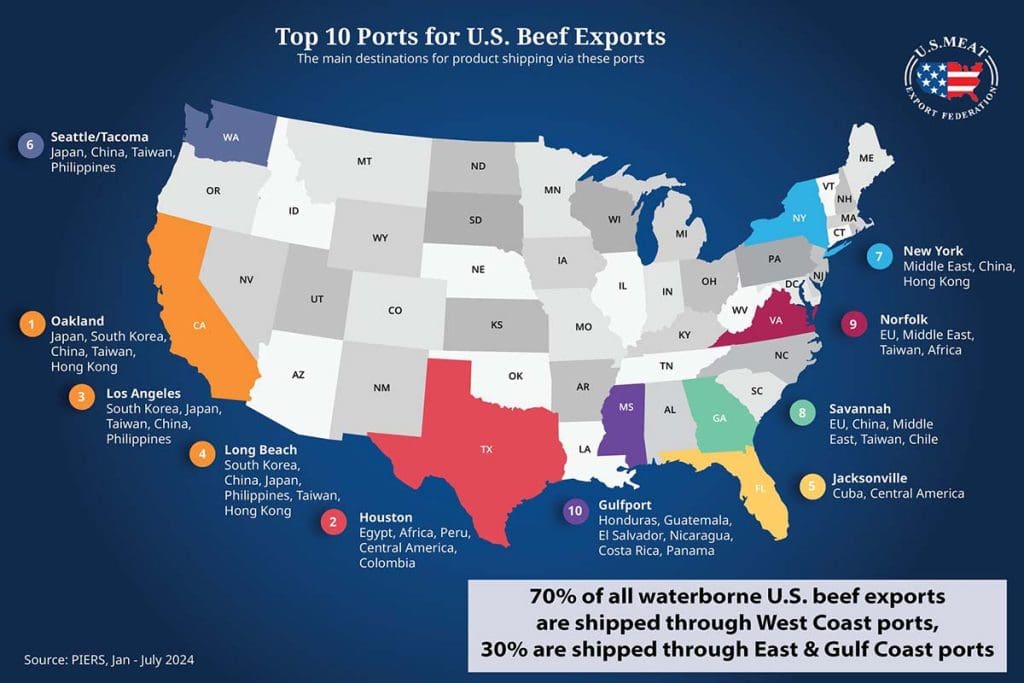US Port strike could deliver serious impact for Australian beef exports
Australian beef exporters are looking on intently this week as a major waterside stoppage threatens to disrupt export trade into the United States – our biggest export market.
Waterside workers are threatening to strike as early as Tuesday next week in US East Coast and Pacific Ports as wages negotiations deteriorate after months of dialogue.
The United States is easily Australia’s largest beef and lamb export market this year, accounting for 235,000t of chilled and frozen beef by the end of August, plus 57,000t of lamb and mutton.
The US Maritime Alliance – the company representing container shipping line operators – has this week filed an Unfair Labour Practice charge with the US National Labor Relations Board due to the International Longshoreman’s Union’s (waterside workers) refusal to negotiate. They are looking for an injunction that would force the union back to the table to resume negotiations.
If the two fail to reach an agreement by Monday, the ILU is threatening to takes strike action from next Tuesday, 1 October, which could paralyse US East Coast and Gulf of Mexico ports if it persists.
While the biggest proportion of Australian chilled higher quality beef exports arrive in the US via west coast ports (likely to be unaffected by the current dispute), the majority of frozen trimming used for hamburgers arrives via the big east coast ports like Philadelphia, New York and New Jersey.
Users are already making contingency plans, with some looking for alternate ports to unload, and others even examining the use of airfreight for some higher value items, Beef Central as told.
Indications were that between 40,000 and 50,000 US dock workers would strike simultaneously, if action processed next week. Workers are asking for an immediate 12.8pc wages increase, on top of their current $US$39/hour rate of pay.

Young Australian, James Blok, pictured above, works out of Los Angeles with large NZ listed logistics company, Mainfreight as the company’s perishable development manager for the Americas region.
He said any strike action next week would inevitably put pressure on US west coast ports for inbound freight like beef and lamb out of Australia and New Zealand.
“It would inevitably create major congestion, with boats backing-up, and containers would then become hard to get, forcing prices higher,” he said.
“And any product for use by east-coast customers would face additional freight cost from the west coast ports across the country by road or rail.”
He said one estimate suggested an additional US$8000 per container to trans-ship a refrigerated container from the US west coast to the east, overland.
“There’s certainly a fair bit of product still in cold storage, but while a few of my customers are thinking of ‘running the gauntlet’ to see what happens, we’ve been told that if a strike eventuates, there will be nobody to monitor container plugs (electricity connection) at the wharf,” he said.
“That creates it own risks – but we simply don’t know if it will be a one day strike or it lasts a month, or whether they work half-days to continue to shift some freight.”
“But what we do know is that for every one day that product is held up, it creates five days of backlog.”
Already, some shipping companies had started increasing surcharge fees to mitigate customers trying to ship product into the East Coast and Gulf ports, Mr Blok said – in some cases $3000 to $5000 per container.
While there have been West Coast US wharf strikes in recent years, the current episode is the first seen on the East Coast since 1977.
“At present, nobody knows how things are going to pan-out,” Mr Blok said. “Everyone is scrambling to see what everyone else does.”
Asked whether he was aware of port users yet considering diverting product away from the US to other markets, Mr Blok said he did not think it had yet got to that stage.
“San Francisco and LA can still take a fair bit of inbound product, but it will quickly back up,” he said.
“But certainly I have clients who are looking at airfreight as a contingency, to maintain supply to valued customers. That then goes from an extra US30c/kg on a 40-foot reefer to an extra US$5/kg increase to great freight to market. I don’t think that would happen on frozen trimmings, but more likely on chilled better quality product like organic, Certified Grassfed, Angus and Wagyu.”

US MEF concerns
The US Meat Export Federation has issued warnings about the potential impact of the strike action.
“The largest ports for US beef and pork exports are on the West Coast, the three big ports there, but that doesn’t mean that the East and Gulf Coast isn’t important,” said Dan Halstrom, president of USMEF.
Last week, USMEF and 177 trade associations urged the White House and Congress to help bring the two sides together to avoid the port shutdown.
“Redirecting to the West Coast is a potential, very short-term solution, but it’s by no means a long-term solution at all, because it’s not just US beef and pork,” Mr Halstrom said.
“You’ve got all sorts of commodities that use these same ports. We’re challenged to export all of our product today using all the ports, so we cannot afford a shutdown in any part of the supply chain.
“Here we are just a few days away from the expiration of the contract on September 30. We need to get the White House or anyone else involved that can help to spur discussions to get back to the table and avoid any kind of interruption of service later this month.”
